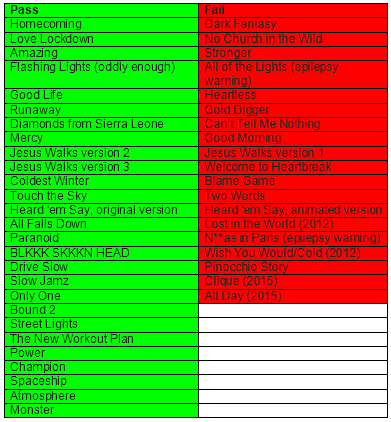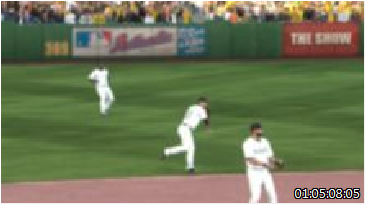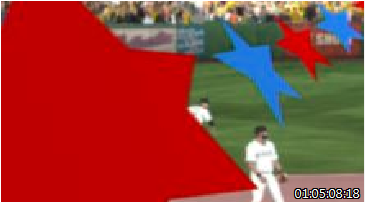Seizure-inducing images found in 6 video games in New York Times holiday gift guide
Posted: 12/07/2015 Filed under: Results of safety testing | Tags: computer games, epilepsy, flash, flicker, photosensitive epilepsy, seizures, video games 2 Comments When choosing a video game for someone on your holiday gift list (or for yourself), wouldn’t it be good to know whether the game contains images that could trigger a seizure? The seizures caused by certain video game visuals are a health risk that most people don’t stop to consider.
When choosing a video game for someone on your holiday gift list (or for yourself), wouldn’t it be good to know whether the game contains images that could trigger a seizure? The seizures caused by certain video game visuals are a health risk that most people don’t stop to consider.
They’re also more common than people realize.
So at this time of year I like to provide some guidance on seizure likelihood in the games you might be thinking of buying. I test the games recommended in holiday gift guides, looking for the types of image sequences that can provoke seizures.
Today I’m reporting on the 10 video games suggested as gifts this year by the New York Times. Take a look at the introduction to the video games section of the guide.
“Buying someone a new video game can be a little like sending a family member on an unexpected foreign trip. It’s a nice gesture, and will surely be appreciated, but it’s awfully hard to know whether you’ve picked the right destination….Here are a few places to consider taking yourself, or your loved ones, on vacation this winter.”
— New York Times 2015 Holiday Gift Guide
There’s no hint in the prose above that the “right destination” could involve more than the entertainment value of the game. The narrative reads as though the worst possible consequence of your buying choice could be a less-than-totally-fun game experience. The “right destination” stakes actually are much higher for some people, since seizures are pretty serious business.
How to know the level of risk
- There is no practical way for consumers to know in advance whether a given video game contains the types of flashing and pattern movements that can provoke seizures. Games are rated for mature content and violence but not for seizure risk. One obvious clue, sometimes provided by the game studios, is the presence of lots of quick flashes in the promotional trailer.
- Visually provoked seizures can happen in individuals with no history of seizures.
- There is no way to know whether an individual might be at risk for visually induced seizures. They may not have encountered the specific visual provocation that leads to a seizure. Or they may have had a seizure while playing, without realizing it.
- Seizures can be hard to identify–many are very subtle and don’t involved falling down or lots of movement. Even subtle seizures, though, can be followed by significant impairments: difficulties with concentration and disruption of emotional control and sleep patterns.
Which games in the Times gift guide appear to be OK?
Using software that analyzes visual sequences for the types of rapidly flashing images and moving patterns that can produce seizures, I tested the 10 games recommended by the Times buying guide. Incidentally, this software is intended for developers, not for folks like you and me–it allows them, should they opt to use it–to deliver a safer consumer product. This chart shows the results:

Recommended games from the 2015 New York Times holiday gift guide
I’ll get to the details in just a bit of how I do the testing—there is no way I can test anywhere near all the scenes and story lines in a game. I’m not a one-person quality assurance department! Basically, after looking at and submitting multiple clips of a given game to an analysis tool designed for detecting seizure-inducing images, I eventually either find material that poses a seizure risk, or determine that further testing won’t uncover any.
Please remember that there are no guarantees your results will match mine and that many variables affect a person’s susceptibility to visually induced seizures.
Testing methodology
I run downloaded gameplay clips, cinematic clips, and promotional trailers for each game and submit the sequences to an application called the Harding Flash and Pattern Analyzer. The FPA is widely used by producers and networks in the UK—including by the BBC—to reduce the risk of seizures from material on broadcast TV. I don’t know how many of the major game developers in this country use the FPA–they keep such information very much to themselves.
The analyzer examines video sequences for very specific and measurable image qualities that researchers have found can trigger seizures:
- rapidly alternating light and dark images (flash/flicker)
- certain stripes and geometric patterns with high contrast
- large areas of very bright (“saturated”) red
- problem images take up more than one quarter of the total screen area
If the first clip I test of a game fails the safety test, I note that and move on to test the next game. If no safety violations are found, I typically test at least 4 or 5 additional clips of that game–sometimes more, if I have a hunch due to the game genre and/or overall look of the sequences that there might be unsafe “footage” that I haven’t yet found.
Games I’ve listed as safe could have seizure-provoking sequences that I was unable to locate. I don’t do this testing while actually playing video games. Instead I work with video clips available online, some of which are official marketing and gameplay trailers; others are cutscenes and gameplay sessions posted by reviewers or fans. I avoid testing any clips of gameplay from modified game software.
Disclaimers
Each person’s seizure threshold can be affected by a number of factors apart from the visual stimulus itself, including illness, hunger, stress, fatigue, alcohol, medications, length of play, and the player’s menstrual cycle, among others. So a game that ordinarily seems OK may trigger a seizure in that same player under different conditions.
Other games tested in 2015
Holiday buying/year-end isn’t the only season for seizure guidelines compliance testing. I’ve tested additional titles this year. You can find results here and here. Also here.
41 percent of Kanye’s videos can make you seize
Posted: 09/08/2015 Filed under: Music Videos, Results of safety testing | Tags: epilepsy advocacy, flash, flicker, Kanye West, music videos, photosensitive epilepsy, seizures Leave a comment
Kanye West accepts the Video Vanguard Award during the 2015 MTV Video Music Awards on August 30 in Los Angeles. (Photo by Kevin Winter/MTV1415/Getty Images For MTV)
Because Kanye West received the Michael Jackson Video Vanguard Award at last weekend’s 2015 MTV Video Music Awards, and because there were seizure risks found with some of his videos, I wanted to know how many of his music videos pose that risk. I wrote previously about a couple of his videos— All of the Lights (2011), and Lost in the World (2012)—that contain seizure-inducing images. Another one I wrote about for its seizure-inducing content, N**as in Paris (2012), was made with Jay-Z.
So in the week since Kanye was recognized for his achievement in music videos, I’ve tested as many of his music videos as I could—46—to determine how many contain flashing/moving image sequences capable of triggering seizures in sensitive individuals. My sample included only videos where Kanye is the primary performer, where he would have had artistic control over the visuals. I didn’t include those made jointly with Jay-Z or if Kanye was a featured guest on a video made by other artists.
41 percent of Kanye’s videos —that’s 19 of 46—could give you a seizure if you are vulnerable to visually induced seizures. OK, but has he stopped releasing videos that can bring on seizures? Did Kanye change his production style after UK-based Epilepsy Action called out the problem videos a few years back? Nope. The two videos I tested from 2015 both failed the seizure guidelines image analysis test.
Here are the results from the Harding Flash and Pattern Analyzer, a tool designed to detect video images that can trigger seizures in people with photosensitive epilepsy. Ironically, the video titled “Flashing Lights” passed the Harding test.
“Throughout his career, West has blended musical and visual artistry to powerful effect.” — press release announcing the Video Vanguard Award.
Best games of E3 2015: how many look risky?
Posted: 06/28/2015 Filed under: Results of safety testing | Tags: computer games, E3, flash, flicker, photosensitive epilepsy, seizures, video games 1 Comment Games industry websites and journalists have announced their picks for the best new video games demonstrated at this month’s annual Electronic Entertainment Expo (E3).
Games industry websites and journalists have announced their picks for the best new video games demonstrated at this month’s annual Electronic Entertainment Expo (E3).
That lets me get to work assessing those games for seizure risk, so I can identify which popular titles in the next crop of releases are less likely to trigger seizures. (I suspect I’m one of very few on the planet who tunes in for this purpose to the annual “best-of” video game lists. I want to see if the development studios are doing more to cut down on image sequences that can set off seizures in people with photosensitive epilepsy.)
I tested the winners chosen by Hardcore Gamer in 9 game categories. Five of the winners—including the Best Game of Show winner, Deus Ex: Mankind Divided—contained seizure-provoking flashes and/or patterns.
Here are my results, using the Harding Flash and Pattern Analyzer to check for images likely to trigger seizures in individuals with photosensitive epilepsy. Please remember that there are no guarantees your results will match mine and that many factors affect a person’s susceptibility to visually induced seizures. Also, the seizure safety guidelines are designed to protect most (97 percent) but not all people with photosensitive epilepsy.
 Testing methodology
Testing methodology
I run downloaded gameplay clips, cinematic clips, and promotional trailers for each game and submit the sequences to the Harding Flash and Pattern Analyzer. The FPA is widely used by producers and networks in the UK—including by the BBC—to reduce the seizure risk of all material on broadcast TV.
The analyzer examines video sequences for very specific and measurable image qualities that researchers have found can trigger seizures:
- rapidly alternating light and dark images (flash/flicker)
- certain stripes and geometric patterns with high contrast
- large areas of very bright (“saturated”) red
- problem images take up more than one quarter of the total screen area
If the first clip I test of a game fails the guidelines compliance test, I note that and move on to test the next game. If no violations are found, I typically test at least 4 or 5 additional clips of that game–sometimes more, if I have a hunch due to the game genre and/or overall look of the sequences that there might be unsafe “footage” that I haven’t yet found.

The image analyzer found Deus Ex: Mankind Divided contained images flashing at a rate that can provoke seizures.
Disclaimers
Games with a PASS result could have seizure-provoking sequences that I was unable to locate. I don’t do this testing while actually playing these video games. Instead I work with video clips available online, some of which are official marketing and gameplay trailers; others are cutscenes and gameplay sessions posted by reviewers or fans. I avoid clips showing games that have been modified with other software.
Each person’s seizure threshold can be affected by a number of factors apart from the visual stimulus itself, including illness, hunger, stress, fatigue, alcohol, medications, length of play, and the player’s menstrual cycle, among others. So a game that seems OK may trigger a seizure in that same player under different conditions.
Video Game of the Year fails seizure safety guidelines test
Posted: 03/05/2015 Filed under: Results of safety testing, Seizure Warnings | Tags: computer games, photosensitive epilepsy, seizures, video games Leave a comment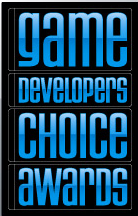 The Game Developers Choice Game of the Year Award was given yesterday to Middle-earth: Shadow of Mordor, a title containing scenes that can provoke epileptic seizures. The game’s visual sequences violate guidelines for reducing the risk of seizures provoked by flashing and/or other provocative visual stimuli.
The Game Developers Choice Game of the Year Award was given yesterday to Middle-earth: Shadow of Mordor, a title containing scenes that can provoke epileptic seizures. The game’s visual sequences violate guidelines for reducing the risk of seizures provoked by flashing and/or other provocative visual stimuli.
Game Developers Choice Awards are voted on by an invitation-only group of leading game creators across the video game industry, and are presented at the annual Game Developers Conference, an event that attracts more than 20,000 attendees. Here are some excerpts from the conference website describing the Game Developers Choice Awards:
- the premier accolades for peer recognition in the digital games industry
- innovation and excellence in the art of making games
- recognize and celebrate the creativity, artistry and technical genius of the finest developers and games created in the last year
You get the idea. Consumer safety and inclusiveness, though, are apparently–no surprise–absent from the selection criteria.
So what?
You may have heard that photosensitive epilepsy, the condition causing vulnerability to visually provoked seizures, is very rare. It’s more common than studies have shown, and many cases go unreported. Seizures can be very subtle events that don’t draw attention, meaning that the individual and anyone with that person may have no idea a seizure has happened. Whether or not a seizure is an obvious event, it can bring on a range of disabling physical and cognitive after-effects as well as mood changes.
Even though video games routinely carry seizure warnings, only some of them contain images that could provoke seizures. Unfortunately, consumers have no way of knowing which games have these images. So I have been testing popular games with an application designed to identify image sequences with a high likelihood of provoking seizures in people with photosensitive epilepsy.

Hearthstone: Heroes of Warcraft, the only Game of the Year Award nominee that passed the seizure safety test, is a digital version of a trading cards-based strategy game.
Contenders for Game of the Year
The winning game was chosen from a field of five nominees, only one of which–Hearthstone: Heroes of Warcraft (Blizzard)–tested as seizure-safe didn’t fail the seizure detection test in the sequences I tested.***Please note that while my testing didn’t find unsafe sequences in Hearthstone, a Reddit poster had seizures triggered by the game. I’ve previously posted on the other three nominated games that tested as unsafe:
Bayonetta 2 (Platinum Games/Nintendo)
Destiny (Bungie/Activision)
Alien: Isolation (Creative Assembly/Sega)
Testing methodology
I run downloaded gameplay clips, cinematic clips, and promotional trailers for each game and submitted the sequences to the Harding Flash and Pattern Analyzer. The FPA is widely used by producers and networks in the UK—including by the BBC—to reduce the hazard of seizures from all material on broadcast TV. It examines video sequences for very specific and measurable image qualities that researchers have found can trigger seizures:
- rapidly alternating light and dark images (flash/flicker)
- certain stripes and geometric patterns with high contrast
- large areas of very bright (“saturated”) red
- problem images take up more than one quarter of the screen
If the first clip I test of a game fails the safety guidelines test, I note that and move on to test the next game. I typically test at least 4 or 5 additional clips of a game if no guidelines violations are found initially. If I have a high level of suspicion due to the game genre and/or overall look of the sequences that there might be unsafe “footage” that I haven’t yet found, I may test a lot more clips.
I work with video clips available online, some of which are official marketing and gameplay trailers; others are cutscenes and gameplay sessions posted by reviewers or fans. I avoid clips showing games that have been modified with other software.
Disclaimers***
Your results could vary. Games that I report to be compliant with seizure reduction guidelines could have seizure-provoking sequences that I was unable to locate. The seizure reduction guidelines are designed to eliminate seizures in 97 percent (not 100) of inividuals with photosensitive epilepsy.
In addition, the seizure threshold of individuals is affected by a number of factors including illness, hunger, stress, fatigue, length of play, and the player’s menstrual cycle, among others. So a game that seems OK for a given individual may trigger a seizure in that same person under different conditions.
2 of these 4 Xbox games don’t cause seizures!
Posted: 12/04/2014 Filed under: Results of safety testing | Tags: computer games, flash, flicker, Nintendo, photosensitive epilepsy, Playstation, seizures, Sony, video games Leave a comment
First-person shooter game Halo: The Master Chief Collection was one of the recommended Xbox titles with a higher seizure risk.
Half of the Xbox-exclusive games selected by GamesBeat for its 2014 holiday gaming guide appear to be free of seizure-provoking visuals. There were just 4 Xbox games in the buying guide, so we’re talking about exactly 2 games that meet seizure safety guidelines. I don’t know how representative this sample is of the universe of Xbox-exclusive titles.
Disney Fantasia: Music Evolved isn’t a game in the conventional sense; it’s a rhythm game played by the motion of the player’s arms, enabled by the motion-sensing Kinect controller. There are no battle scenes that might set off visually risky explosions, or races with crashes and fast-moving scenery. Instead, when players “conduct” to the beat of music selections, all sorts of colored patterns are created and set in motion on the screen. It’s visually interesting yet not overstimulating. There’s a lot of black space separating the smaller colorful elements.

Sunset Overdrive, released by Microsoft Studios, is a third-person shooter game, a relatively low risk genre, seizure-wise. Because these games tell a story from the perspective of an observer of the action, scenes are shown from a wide angle. This means that, unlike first-person shooters, any bright, explosive flashes and rapidly swirling debris don’t dominate the field of view. The larger the screen area of patterns flashing images, the higher the likelihood is that those visual effects might provoke a seizure.

The Halo image at the start of this post is shown here in the upper left of a screen from the seizure safety testing application. The image occurs in a stretch of gunfire with flash levels exceeding seizure safety guidelines, as shown by the red line on the graph.
So it’s not surprising that first-person shooter Halo: The Master Chief Collection contains seizure-provoking images. Its predecessor Halo 4, which I tested 2 years ago along with other FPS games, failed the flash and pattern analyzer test, too.
Not so surprising, either, that the racing game Forza Horizon 2 violated seizure safety guidelines. As I’ve previously found, the quick cuts, fast-moving scenery, and dramatic collisions featured in the racing genre result in games that exceed or approach seizure safety guidelines. The original version of the game, which I tested nearly a year ago, contained a lot of scenes that flirted with safety guidelines limits, but I didn’t find actual violations.
Summing up GamesBeat’s 2014 holiday gift guide
This completes my seizure risk assessment of games chosen for GamesBeat’s 2014 holiday gift guide. In recent posts I’ve reported on the risk of seizures in the guide’s recommended multiplatform games and games exclusive to Nintendo, Sony, and PCs. After testing all 43 games in the GamesBeat 2014 holiday guide, it appears that 26 titles–60 percent–contain image sequences capable of provoking seizures.
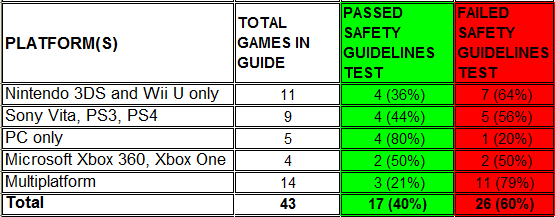
Just 40 percent of games recommended in the GamesBeat holiday guide complied with seizure safety guidelines.
These are supposed to be the industry’s best games–how often is higher seizure risk is associated with the worst games? Or the not-especially-noteworthy? If I had unlimited time and testing resources, we could find out. Consumers deserve to see reviewers rate games for seizure risk, not just for graphics quality, speed/performance, modes of play, characters’ personalities, levels of difficulty, modes of play, frame rate, music, and so on.
Disclaimers
Please remember that your results could vary. Games that pass the seizure guidelines test could have seizure-provoking sequences that I was unable to locate. I don’t do this testing while actually playing these video games and I don’t see all the scenes. Instead I work with video clips available online, some of which are official marketing and gameplay trailers and cutscenes; others are gameplay sessions posted by reviewers or fans. I do not test fans’ gameplay clips if the original game was modified with other software.
In addition, the seizure threshold of individuals is affected by a number of factors including illness, hunger, stress, fatigue, length of play, and menstrual cycle, among others. So a game that seems OK may subsequently trigger a seizure under different conditions.
Testing methodology
I run downloaded gameplay clips, cinematic clips, and promotional trailers for each game and submit the sequences to the Harding Flash and Pattern Analyzer. The FPA is widely used by producers and networks in the UK—including by the BBC—to protect most (97 percent) but not all people with photosensitive epilepsy viewing broadcast TV. It examines video sequences for very specific and measurable image qualities that researchers have found can trigger seizures:
- rapidly alternating light and dark images (flash/flicker)
- certain stripes and geometric patterns with high contrast
- large areas of very bright (“saturated”) red
- problem images take up more than one fourth of the screen
If the first clip I test of a game fails the safety test, I move on to test the next game. I typically test at least 4 or 5 additional clips of a game if no violations are found initially. If I have a high level of suspicion due to the game genre and/or overall look of the sequences that there might be unsafe “footage” that I haven’t yet found, I may test a lot more clips.
Seizures from 7 of 11 best Nintendo games
Posted: 11/21/2014 Filed under: Results of safety testing | Tags: computer games, Nintendo, photosensitive epilepsy, seizures, video games 3 Comments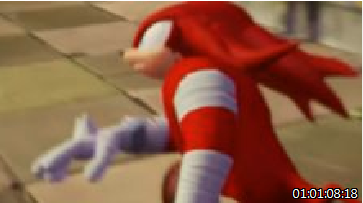
A case history in a 1994 medical journal documented seizures in a 13-year-old boy that were triggered by a Sonic the Hedgehog video game. The Sonic games just tested continue to include seizure-inducing sequences.
Thinking about buying any titles that GamesBeat thinks are the season’s best Nintendo-only games? My testing shows that seven contain seizure-provoking visuals.
Among the Nintendo games that don’t comply with seizure safety guidelines are several that one would expect to be seizure-inducing. Two brand-new animé-style games, Persona Q and Hyrule Warriors, predictably violated the safety guidelines because animé typically does. Unsafe graphics in Sonic the Hedgehog and Super Smash Bros., two of the most well-established game franchises, are consistent with prior seizure-provoking games in their respective product families.

GamesBeat picked these Nintendo-only titles for its early holiday gaming guide this year.
Pokémon video games…
Keeping in mind the so-called Pokémon incident in 1997, I was particularly curious about the seizure risk from the Pokémon games. That event was a Pokémon cartoon broadcast, when about 600 Japanese children simultaneously experienced seizure symptoms severe enough that they were taken to emergency rooms. Maybe because of that history, I thought, perhaps the developers of these games have taken extra care to reduce the risk of photosensitive seizures.
In fact, in the segments I tested of these three games, there were no images that violate seizure safety guidelines. Of the three Pokémon games, one isn’t really a game so much as a set of digital drawing and painting tutorials. Still curious, I put a few other Pokémon games through a seizure guidelines compliance assessment—the others passed, too.
…and Pokémon video game trailers
Hold on, though. Although the Pokémon games themselves games comply with guidelines to reduce seizure risk, a promotional video for these same games violates the guidelines big time! How can that be? Here’s how: a just-released trailer for Pokémon Alpha Sapphire and Omega Ruby is done in a more traditional animé style, while the Pokémon games themselves still use the not-very-animated, not-very-2014, unlikely-to-provoke-seizures animation style of much older games. So beware of seizures from the marketing videos.

…than the Pokémon games it’s promoting. While the game is safe, the eye-catching trailer fails the seizure guidelines compliance test.
Evidently unaware of the seizure hazard from animé, Sports website Sportskeeda.com commented:
“To celebrate the upcoming release, the Pokémon Company has launched an animé style trailer for the two games…It’s pretty cool of Pokémon to release an animé styled trailer, given how popular the series and manga is. And even though the animé and game are very different from each other, fans of the series are still going to appreciate the extra effort.”
When The Pokémon Company in 2012 used this same marketing strategy with an animé promotional trailer to “celebrate” the release of non-animé Pokémon Black 2 and Pokémon White 2, YouTube viewers of the combined trailer lamented that the (seizure-inducing) animé in the promotional clip looked a lot better than the humdrum (visually safer) appearance of the games’ graphics.
These visually jazzed-up trailers would seem to raise customers’ expectations that in future releases The Pokémon Company intends to incorporate animé style into cutscenes and perhaps gameplay.
Testing Methodology
Here’s how I test for compliance with seizure safety guidelines. I submit downloaded gameplay clips and promotional trailers to the Harding Flash and Pattern Analyzer. The FPA is widely used by producers and networks in the UK—including by the BBC—to reduce the seizure risk in viewers from all material broadcast on TV. It examines video sequences for very specific and measurable image qualities that researchers have found can trigger seizures:
- rapidly alternating light and dark images (flash/flicker)
- certain stripes and geometric patterns with high contrast
- large areas of very bright (“saturated”) red
- problem images take up more than one fourth of the screen
Sequences submitted for analysis are video clips available online, some of which are official marketing and gameplay trailers; others are gameplay sessions or cutscenes posted by reviewers or fans. I do not test clips uploaded by fans who have modified the game software.
I typically test at least 4 or 5 clips of a game if no safety violations are found in the first clip. If I have a high level of suspicion due to the game genre and/or overall “look” that there might be unsafe images that I haven’t yet found, I may test a lot more clips. Before finding a clip of Bayonetta 2 that failed the test, I tested about a dozen clips. Its large, fast-moving, brightly colored designs led me to believe there had to be seizure-inducing sequences.
Disclaimer
Your results could vary. Games that pass the compliance test could have seizure-provoking sequences that weren’t in the material I tested. Also, the seizure safety guidelines are designed to protect most (97 percent) but not all people with photosensitive epilepsy.
A game that has caused a person no problems over an extended period of use could still trigger a seizure in the same individual at a different time under different conditions. For reasons not understood by researchers, a person’s vulnerability to visually stimulated seizures changes over time. Photosensitive epilepsy can remain latent during childhood and typically emerges and peaks durng adolescence, and only about 25 percent of people who develop the condition will eventually outgrow it. Furthermore, the seizure threshold of individuals is affected by a number of factors including illness, hunger, stress, fatigue, alcohol, and the player’s menstrual cycle, among others.
Best new PC-only games are safe–pretty much
Posted: 11/03/2014 Filed under: Results of safety testing | Tags: computer games, flash, flicker, photosensitive epilepsy, seizures, video games, World of Warcraft 2 Comments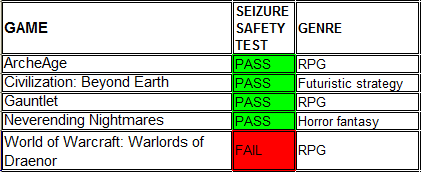 Better news than usual. For people susceptible to photosensitive seizures, the five best exclusive-to-PC games for the holiday shopping season (per GamesBeat) appear safe. Well, mostly.
Better news than usual. For people susceptible to photosensitive seizures, the five best exclusive-to-PC games for the holiday shopping season (per GamesBeat) appear safe. Well, mostly.
There’s one very important caveat: While the gameplay itself seems to stay within visual safety guidelines, a cinematic clip from World of Warcraft: Warlords of Draenor failed image safety tests. You can apparently play World of Warcraft safely, but you need to beware of the risk of seizures from the cinematic game openers and other in-game cutscenes and cinematic material that move the story along. I didn’t give the game a passing rating because it’s likely that players will see the problem video sequences.
Going forward, when testing games for seizure safety, I will routinely test cutscenes in addition to gameplay clips. Unfortunately it’s quite possible that in preparing prior posts I’ve been unaware of some safety failures because I wasn’t systematically looking to test these sequences. I plan to revisit the test results I’ve recently posted and will be updating those posts with any new findings.
Four of the five games are either role-playing (RPG) or strategy games, which tend to be shown from a wide angle that permits scenes showing entire battle fields. These “big picture” scenes are less likely than close-up shots to have areas of flash, saturated color, and patterns that take up a major portion of the screen. Unless these visual effects cover more than one quarter of the screen they do not typically pose a seizure risk.
The flash problem
In the problem sequence in Warlords of Draenor excerpted below, a bright orange screen alternates with a darker screen. The switch between dark and bright happens several times within a fraction of a second. The rapid sequence creates a flash, and because it occurs faster than 3 times per second, it exceeds the flash rate safety limit for photosensitive epilepsy.

The bright orange frames alternating with a black and white image in this sequence from World of Warcraft: Warlords of Draenor creates a flash effect. This sequence of screens, captured by the Harding Flash and Pattern Analyzer, represents roughly a third of a second of video.
For people with photosensitive epilepsy, flashing red (or shades of red) creates an even higher seizure risk. When the video sequence (at bottom of the analysis tool screen capture below) is assessed for seizure safety, an unsafe level of flash is shown in the green line on the graph. The level of red flash (red line on the graph) is even further beyond the safety limit.
Disclaimers
Your results could vary. Games I’ve listed as safe could have seizure-provoking sequences that I was unable to locate. I don’t do this testing while actually playing these video games. Instead I work with video clips available online, some of which are official marketing and gameplay trailers; others are gameplay sessions posted by reviewers or fans. I do not test fans’ gameplay from games that were acknowledged modified with other software.
In addition, the seizure threshold of individuals is affected by a number of factors including illness, hunger, stress, fatigue, length of play, and the player’s menstrual cycle, among others. So a game that seems OK may trigger a seizure under different conditions.
Testing methodology
I run downloaded gameplay clips, cinematic clips, and promotional trailers for each game and submitted the sequences to the Harding Flash and Pattern Analyzer. The FPA is widely used by producers and networks in the UK—including by the BBC—to ensure seizure safety of all material on broadcast TV. It examines video sequences for very specific and measurable image qualities that researchers have found can trigger seizures:
- rapidly alternating light and dark images (flash/flicker)
- certain stripes and geometric patterns with high contrast
- large areas of very bright (“saturated”) red
- problem images take up more than one fourth of the screen
If the first clip I test of a game fails the safety test, I note that and move on to test the next game. I typically test at least 4 or 5 additional clips of a game if no safety violations are found initially. If I have a high level of suspicion due to the game genre and/or overall look of the sequences that there might be unsafe “footage” that I haven’t yet found, I may test a lot more clips.
In recent posts I’ve shown the results of testing editors’ picks for best-of-Sony and best-of-multiplatform games for this year/holiday season. Both groups included lots of seizure-inducing titles. In coming posts I’ll look at best of Nintendo and Microsoft games.
More top 2014 Sony-only games: 5 of 8 unsafe
Posted: 10/14/2014 Filed under: Results of safety testing | Tags: computer games, flash, flicker, photosensitive epilepsy, Playstation, seizures, Sony, the last of us, video games Leave a commentHere’s another batch of exclusive-to-Sony game titles that I tested for seizure safety. These eight games were chosen by Inside Gaming Daily as the year’s best Playstation-only games. Of the eight, five contain images that could provoke seizures in viewers or players.
The test results:
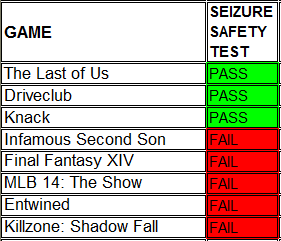
Inside Gaming Daily chose these as the year’s best Playstation 4 2014 titles.
An example of totally unnecessary seizure-provoking material
Scenes of the playing field and the stands in MLB 14: The Show don’t contain seizure-provoking sequences. But the alternating blue and red stars that occasionally scroll across the screen, between plays, for a fraction of a second are a problem. They create enough flash effect and saturated red to provoke seizures. The game could be seizure-safe game just by omitting these graphics sequences.
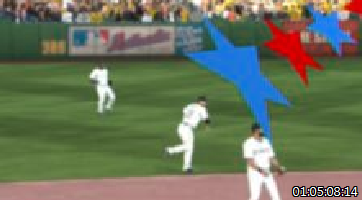
But these fast-moving graphics sequences that appear between plays are not in compliance with safety guidelines for preventing visually-induced seizures.
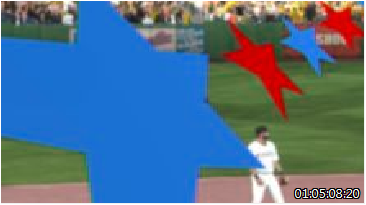
…the alternating colors create a flash effect and include a large screen area of saturated red. This sequence, which appears periodically throughout the game, fails the seizure safety test on both counts.
Testing Methodology
To test the games I submit downloaded gameplay clips and promotional trailers to the Harding Flash and Pattern Analyzer. The FPA is widely used by producers and networks in the UK—including by the BBC—to ensure seizure safety of all material on broadcast TV. It examines video sequences for very specific and measurable image qualities that researchers have found can trigger seizures:
- rapidly alternating light and dark images (flash/flicker)
- certain stripes and geometric patterns with high contrast
- large areas of very bright (“saturated”) red
- problem images take up more than one fourth of the screen
Sequences submitted for analysis are video clips available online, some of which are official marketing and gameplay trailers; others are gameplay sessions posted by reviewers or fans. I do not test fans’ sequences from games that were modified with other software.
I typically test at least 4 or 5 clips of a game if no safety violations are found in the first clip. If I have a high level of suspicion due to the game genre and/or overall look of the sequences that there might be unsafe “footage” that I haven’t yet found, I may test a lot more clips. Then there are games like Entwined–as soon as I started viewing the first clip, I strongly suspected there would be seizure-provoking sequences.
Disclaimer
Your results could vary. Games I’ve listed as safe could have seizure-provoking sequences that I was unable to locate. Furthermore, the seizure threshold of individuals is affected by a number of factors including illness, hunger, stress, fatigue, and the player’s menstrual cycle, among others. So a game that seems OK the first time it’s played may trigger a seizure under different conditions.
Sony’s top 2014 games: 5 of 9 test as unsafe
Posted: 10/08/2014 Filed under: Results of safety testing | Tags: computer games, flash, flicker, photosensitive epilepsy, Playstation, seizures, Sony, video games Leave a comment
Games (and films) in animé art style typically contain many instances of unsafe image sequences. This screen shot is from Fairy Fencer F.
Roughly half of the year’s most eagerly anticipated made-for-Sony video games could set off a seizure. I tested the seizure safety of the nine Sony-only titles selected last month by GamesBeat for its “early holiday gaming guide.” Five games failed the safety test, indicating that their graphics exceed safety guidelines for flash, intense color, and/or patterns known to trigger seizures.
Watch out for animé graphics
In this selection of games exclusive to Sony platforms, those made for the PS3 were more likely to trigger seizures than those for the PS4 or Vita–probably because the PS3 games in this batch of titles were overwhelmingly illustrated in animé style graphics. Animé is the animation style used in the infamous Pokémon cartoon incident in Japan, when hundreds of Japanese children viewing the cartoon experienced seizure symptoms simultaneously and went to emergency rooms.
Here are the results for the nine Sony games:
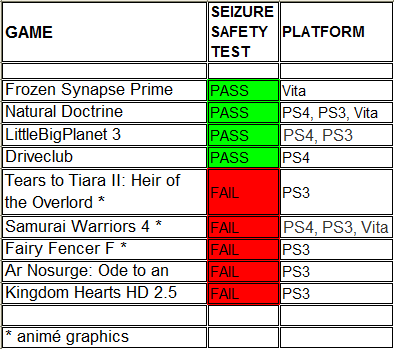
Testing methodology
I run downloaded gameplay clips and promotional trailers for each game and submitted the sequences to the Harding Flash and Pattern Analyzer. The FPA is widely used by producers and networks in the UK—including by the BBC—to ensure seizure safety of all material on broadcast TV. It examines video sequences for very specific and measurable image qualities that researchers have found can trigger seizures:
- rapidly alternating light and dark images (flash/flicker)
- certain stripes and geometric patterns with high contrast
- large areas of very bright (“saturated”) red
- problem images take up more than one fourth of the screen

This completely red screen from a sequence in Fairy Fencer F failed the safety test due to excessive saturated red color.
Sequences submitted for analysis are video clips available online, some of which are official marketing and gameplay trailers; others are gameplay sessions posted by reviewers or fans. I do not test fans’ sequences from games that were modified with other software.
If the first clip I test of a game fails the safety test, I note that and move on to test the next game. I typically test at least 4 or 5 additional clips of a game if no safety violations are found initially. If I have a high level of suspicion due to the game genre and/or overall look of the sequences that there might be unsafe “footage” that I haven’t yet found, I may test a lot more clips. For example, knowing that the fast-moving views in racing games may be seizure-inducing, I tested more than a dozen Driveclub clips.
Similarly, the art style and pace in other games look highly unlikely to pose a seizure risk–I tested only a couple of clips from LittleBigPlanet 3.
Disclaimer
Your results could vary. Games I’ve listed as safe could have seizure-provoking sequences that I was unable to locate. Furthermore, the seizure threshold of individuals is affected by a number of factors including illness, hunger, stress, fatigue, and the player’s menstrual cycle, among others. So a game that seems OK the first time it’s played may trigger a seizure under different conditions.
I’ve already tested what GamesBeat editors consider the year’s biggest games for multiple platforms. In upcoming posts I’ll share test results on their choices for PC-based games and for games exclusively built for Nintendo and Microsoft gaming platforms.
2014’s biggest games: 11 of 14 fail to reduce risk of seizures
Posted: 09/23/2014 Filed under: Results of safety testing | Tags: computer games, flash, flicker, photosensitive epilepsy, photosensitivity, seizures, video games 5 Comments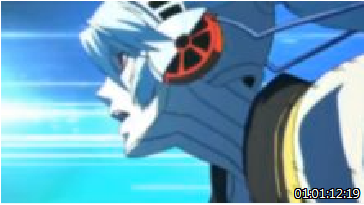
Animation used in Persona 4 Arena Ultimax is Japanese animé style–a bold, flash-filled format that people with photosensitive epilepsy should avoid. Not surprisingly, the game failed the safety test.
It’s that time of year when lots of major video games are released, in advance of the holiday shopping season. The marketing build-up has been underway for many months, with snippets of gameplay shown at industry events and in reviews and cinematic trailers. By testing these snippets I can find out which of these games are likely to create a risk to people vulnerable to visually induced seizures.
The year’s “biggest” games
The editorial staff of GamesBeat (part of tech publication VentureBeat) has already published an “early holiday gaming guide” with its choices for this year’s most eagerly anticipated titles. So far I’ve tested what GamesBeat editors consider the biggest games to be released soon for multiple platforms. In upcoming posts I’ll share test results on their choices for PC-based games and for games exclusively built for Sony, Nintendo, and Microsoft gaming platforms.
Of the 14 multi-platform games, only 3 appear to pose little risk of photosensitive seizures. Images that could provoke photosensitive seizures were found in all the other games.

NOTE: Subsequent testing of The Evil Within (using the final cutscene) on 11/13/2014 revealed that–as shown in this chart–the game fails to meet seizure reduction guidelines. My apologies to anyone who was misled by the original version of this post, in which I listed the game as safe to play.
Methodology
To determine whether a video game is likely to trigger seizures in individuals susceptible to visually induced seizures, I run them through a photosensitive seizure safety analyzer, the Harding Flash and Pattern Analyzer. The FPA is widely used by producers and networks in the UK—including by the BBC—to ensure seizure safety of all material on broadcast TV. It examines video sequences for very specific and measurable image qualities that researchers have found can trigger seizures:
- rapidly alternating light and dark images (flash/flicker)
- certain stripes and geometric patterns with high contrast
- large areas of very bright (“saturated”) red
- problem images take up more than one-fourth of the screen
Visual safety criteria for video sequences are precisely defined in this document used by regulators of broadcast TV in the UK. The criteria were arrived at based on extensive clinical testing.
If the first clip I test of a game fails the seizure guidelines test, I note that and move on to test the next game. I typically test at least 4 or 5 additional clips of a game if no safety violations are found. I don’t do this testing while actually playing these video games. Instead, I work with video clips available online, some of which are official marketing and gameplay trailers; others are gameplay sessions posted by reviewers or fans. I do not test fans’ sequences from games that were modified with other software.
Disclaimer
Your results could vary. Games I’ve listed as meeting image guidelines could have seizure-provoking sequences that I was unable to locate. Furthermore, the seizure threshold of individuals is affected by a number of factors including illness, hunger, stress, fatigue, and the player’s menstrual cycle, among others. So a game that seems OK the first time it’s played may trigger a seizure under different conditions.

